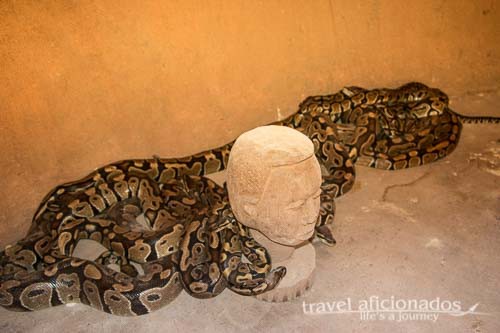Quite a few memorials remind of the dark past of this city, most of them along the route de esclaves, a 4km sandy track that starts at Place Chacha where the slaves were auctioned off. Shaded by a large tree the square now radiates an almost idyllic ambience. Francisco Felix de Souza, the Brazilian slave trader, resided right there, his former villa seems almost modest considering the money he must have made trafficking human cargo to Brazil. Local narrative has Souza watching the horrid business transactions from this very villa, he would even check on the ships leaving through his binoculars until they disappeared on the horizon. From Place Chacha the slaves were marched down to the beach where they were loaded onto boats heading mainly for Santiago/Bahia. Today, a memorial, the Point of No Return, reminds of the many people sold into slavery to the Americas. Many died even before leaving Benin, they are remembered by the Wall of Lamentation.
How was it possible for Souza to set up a business in a region under the control of the Dahomeyan King Guezo? Souza played a game well-known in colonial politics “divide and rule”. He supported King Guezo in a power struggle against his brother and as a reward was allowed to run the slave trade out of Oudiha. Besides King Guezo quickly learned that he would profit from this business as well.
At the small museum in the former Portuguese Fort a few exhibits are on display. Most interesting, photos taken by a French researcher in Benin and Salvador/ Brazil in the 1920s. He portrayed dances, ceremonies and traditional dresses and proved the strong cultural ties between the two places due to the slave trade.
Today, Ouidah is a pleasant town, none of the usual hectic and loud traffic, since most roads are still not tarred. A voodoo temple can be visited, which is best described as a compound with a few small buildings surrounded by a wall, one is a room full of pythons.
The python cemetery and the small house where the priests receive their “clients”, is off limit for visitors. A few shrines for various divinities and a holy tree make up the rest. Nothing that would convey the strong spirituality that is associated with this “religion”.
The Sacred Forest on the other hand is much more atmospheric, a small, tranquil wooded area with sculptures of various divinities. Most intriguing, a temple visitors are not allowed to enter and most important: a tree that fell over but put itself back up in place before is was cut up.

Sacred Forest, Ouidah
A great way to reach the voodoo capital from Cotonou is via Route des Peches, a sandy road running parallel to the beach and lined with palm trees for most parts. Fishing villages and restaurants that are deserted during the week come to life on weekends.
Transport: Minibus Ouidah - Cotonou: 1000 CFA, motorbike from beach to center of Ouidah: 500CFA




No comments yet.